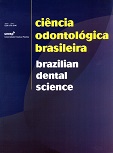Stem cells behaviour on titanium surface modificated by plasma
DOI:
https://doi.org/10.14295/bds.2012.v15i2.757Palavras-chave:
Implante, Titânio, PlasmaResumo
Nos últimos anos tem-se observado um grande crescimento em tecnologias para modificação de superfícies de implantes dentais visando reduzir o tempo de espera pela cicatrização, assim como possibilitar seu uso com sucesso em áreas de baixa densidade óssea. Dentre esses métodos de modificação, a nitretação por plasma tem apresentado ótimos resultados. No presente trabalho, estudou-se superfícies de titânio comercialmente puro (Grau II) modificadas através de dois tratamentos por plasma diferentes (nitretação planar e nitretação em cátodo oco), com o objetivo de obter uma otimização da superfície para aplicações biomédicas. Uma avaliação da composição química e um estudo da rugosidade e textura destas amostras foram realizados. Em seguida, depositou-se células-tronco sobre essas superfícies e uma comparação entre as novas propriedades obtidas e a proliferação celular foi feita. Os resultados mostraram que a nitretação por plasma produziu mudanças significativas na textura superficial das amostras de titânio. A rugosidade foi superior nas amostras nitretadas em cátodo oco. Encontrou-se diferença estatisticamente significante na proliferação celular das amostras nitretadas em cátodo oco quando comparadas com as amostras sem tratamento. Essas técnicas de modificação são, portanto, efetivas e possuem influência direta nas características da superfície e no comportamento de células-tronco.
Downloads
Downloads
Publicado
Como Citar
Edição
Seção
Licença
TRANSFERÊNCIA DE DIREITOS AUTORAIS E DECLARAÇÃO DE RESPONSABILIDADE
Toda a propriedade de direitos autorais do artigo "____________________________________________________________________" é transferido do autor(es) para a CIÊNCIA ODONTOLÓGICA BRASILEIRA, no caso do trabalho ser publicado. O artigo não foi publicado em outro lugar e não foi submetido simultaneamente para publicação em outra revista.
Vimos por meio deste, atestar que trabalho é original e não apresenta dados manipulados, fraude ou plágio. Fizemos contribuição científica significativa para o estudo e estamos cientes dos dados apresentados e de acordo com a versão final do artigo. Assumimos total responsabilidade pelos aspectos éticos do estudo.
Este texto deve ser impresso e assinado por todos os autores. A versão digitalizada deverá ser apresentada como arquivo suplementar durante o processo de submissão.




























